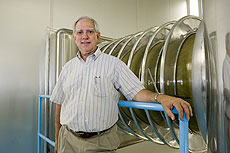Chuck Schmidt retires today

Chuck Schmidt stands in front of the Cockcroft Walton, the pre-accelerator, which produces H- ions. Schmidt was instrumental in implementing the H- design.
When Chuck Schmidt was 2-years-old, he stuck his mother's keys in an electrical outlet.
"My cry alerted the whole neighborhood," Schmidt said.
The shock might have deterred most children from tinkering with electronics, but Schmidt attributes his love for science to that experience. After 40 years of working to get and keep Fermilab's Linac and accelerators running smoothly and efficiently, Schmidt will retire today.
Schmidt's career at Fermilab began in 1969 when he joined the Main Ring Group. He remembers working with a team to steer the magnets in order to get the first beam around the main accelerator. He also worked as operations chief, close to the equivalent of today's run coordinators.
But Schmdt, ID number 432, is best known for the H- source, the machine that isolates and ionizes hydrogen atoms.
"He is pretty much single-handedly responsible for the H- sources at the laboratory," said Larry Allen, an engineering physicist in the Accelerator Division who has worked with Schmidt for the past 37 years.
Schmidt calls the conversion from proton beam to H- in the Linac a highlight of his career.
"I saw that the Booster wasn't working well with protons and I looked at results from Argonne National Laboratory, which had developed the first H- source," Schmidt said.
Schmidt also worked on the ion source for the Loma Linda project and most recently worked on electron cooling. He also headed the Linear Accelerator Department from 1989 to 1994, and then served as the deputy head of the same department when it was renamed the Proton Source Department, until 2001.
But what colleagues reflect on is Schmidt's personality.
"Chuck has always been the most conscientious guy I've ever met," Allen said. "He was very protective of his employees."
Schmidt plans to travel with his wife, Judy, and work around their Naperville home during his retirement. He also has a guest scientist appointment, and hopes to come back to the laboratory frequently to work on the High Intensity Neutrino Source, among other things.
"I do feel like I've accomplished a lot in the 40 years I've been here," Schmidt said. "It has been a tremendous enjoyment."
-- Rhianna Wisniewski |